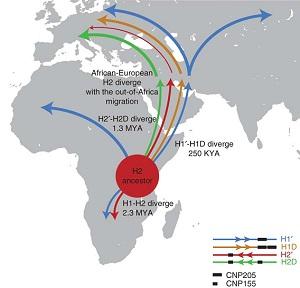Using AI to control energy for indoor agriculture
30 September 2024
Published online 15 July 2012

Chromosomal inversion occur when a chromosome breaks and is rearranged and a segment is reversed from end to end. This change can play a role in genomic evolution.
A recent study suggests that the inversion of a chromosome which causes microdeletion syndrome was the original configuration of that chromosome in humans. Carriers of the H2 haplotype, in which a segment located at 17q21.31 is reversed, are more predisposed to the condition which causes developmental delay and intellectual disability. Direct haplotypes (H1) are less predisposed to the condition.
In a study whose results are published today in Nature Genetics, an international team of researchers, including Muntaser Ibrahim from the University of Khartoum, Sudan, studied the genome of 2,700 individuals from African and European origin. They found five different structural haplotypes for H1 and three for H2. These haplotypes were much more common in European populations so that the incidence of the syndrome is higher in Europeans than among African people.
After studying the diversity of the direct and inverted haplotypes in different groups, including hunter-gatherers from Africa, the researchers propose that the inverted H2 haplotype was the original configuration of the 17q21.31 region in humans and that approximately 2.3 million years ago, the inversion reconfigured to the direct orientation haplotype H1.
The study's authors suggest that the H1 orientation then spread out from central Africa across the rest of the continent throughout Homo ancestral populations and became the dominant form. Duplication of both the H1 and H2 haplotypes occurred separately, with the H2 duplication taking place approximately 1.3 million years ago and the H1 duplication as recently as 250,000 years– both before human migration out of Africa. The H1 stayed predominant in western Africa while the rest of the haplotypes spread out to the Middle East, Asia and Europe when humans migrated out of Africa.
doi:10.1038/nmiddleeast.2012.99
Stay connected: